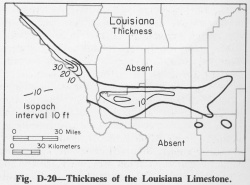Louisiana Limestone
Lithostratigraphy: Knobs Megagroup >>New Albany Shale Group >>Louisiana Limestone
Chronostratigraphy: Paleozoic Erathem >>Devonian System >>Upper Devonian Series
Allostratigraphy: Kaskaskia Sequence
Primary source
Willman, H. B., Elwood Atherton, T. C. Buschbach, Charles Collinson, John C. Frye, M. E. Hopkins, Jerry A. Lineback, and Jack A. Simon, 1975, Handbook of Illinois Stratigraphy: Illinois State Geological Survey Bulletin 95, 261 p.
Contributing author(s)
Charles Collinson and Elwood Atherton
Name
Original description
The Louisiana Limestone (Keyes, 1892, p. 289).
Derivation
Named for Louisiana, Pike County, Missouri, where it is well exposed in the Mississippi River bluffs.
Other names
History/background
Type section
Type location
No type section was designated for the Louisiana Limestone, but a prominent exposure on the south side of Louisiana, where it is underlain by the Saverton Shale and overlain by the Hannibal Shale, is commonly accepted as the type section.
Type author(s)
Type status
Reference section
Reference location
Reference author(s)
Reference status
Stratigraphic relationships
The Louisiana is unconformably overlain by the "Glen Park" Formation, but, as the faunas indicate only a short interruption in sedimentation, the unconformity appears to be related to minor uplift on the flank of the Lincoln Anticline.
Extent and thickness
The Louisiana occurs in an area 10-25 miles wide extending eastward from the Mississippi River into west-central Illinois (fig. D-20). It is a lenticular body as much as 40 feet, but more commonly 10-20 feet thick. It is exposed along the Mississippi and Illinois Valleys in Pike, Calhoun, and Jersey Counties.
Lithology
The formation is light gray to buff, lithographic limestone with thin shale partings and dolomite interbeds. The limestone is very pure and is probably a chemical precipitate.
Core(s)
Photograph(s)
Contacts
Well log characteristics
Fossils
The Louisiana Limestone contains a large variety of macrofossils dominated by small brachiopods, particularly Schuchertella, Chonetes, Cyrtina, and Ambocoelia, but microcrinoids, bryozoans, and ostracodes also are common (Williams, 1943).
Age and correlation
The Devonian or Mississippian age of the Louisiana Limestone and its relation to the similar McCraney Limestone, which is exposed in Illinois essentially within sight of the type Louisiana in Missouri, were major controversies for many years (Collinson, 1961; Scott and Collinson, 1961). Studies of the conodont faunas demonstrated that the Louisiana was of Upper Devonian age and the McCraney was of Mississippian age, resolving both problems and substantiating field tracing of the units in the Mississippi River bluffs in Illinois.
Environments of deposition
Economic importance
Remarks
References
COLLINSON, CHARLES, 1961, Kinderhookian Series in the Mississippi Valley, in Northeastern Missouri and west-central Illinois: Kansas Geological Society Guidebook, 26th Annual Field Conference, Missouri Geological Survey Report of Investigations 27, p. 100-109; Illinois State Geological Survey Reprint 1961-U.
KEYES, C. R., 1892, Principal Mississippian section: Geological Society of America Bulletin, v. 3, p. 283-300.
SCOTT, A. J., and CHARLES COLLINSON, 1961, Conodont faunas from the Louisiana and McCraney Formations of Illinois, Iowa, and Missouri, in Kansas Geological Society Guidebook, 26th Field Conference, northeastern Missouri and west central Illinois: Missouri Geological Survey Report of Investigations 27, p. 110-141; Illinois State Geological Survey Reprint 1961-V.
WILLIAMS, J. S., 1943, Stratigraphy and fauna of the Louisiana Limestone of Missouri: USGS Professional Paper 203, 133 p.
ISGS Codes
| Stratigraphic Code | Geo Unit Designation |
|---|---|
